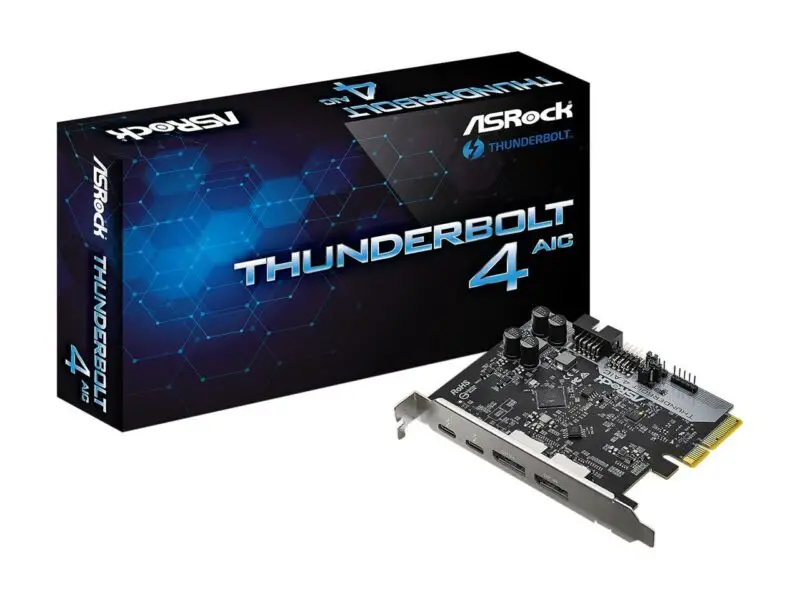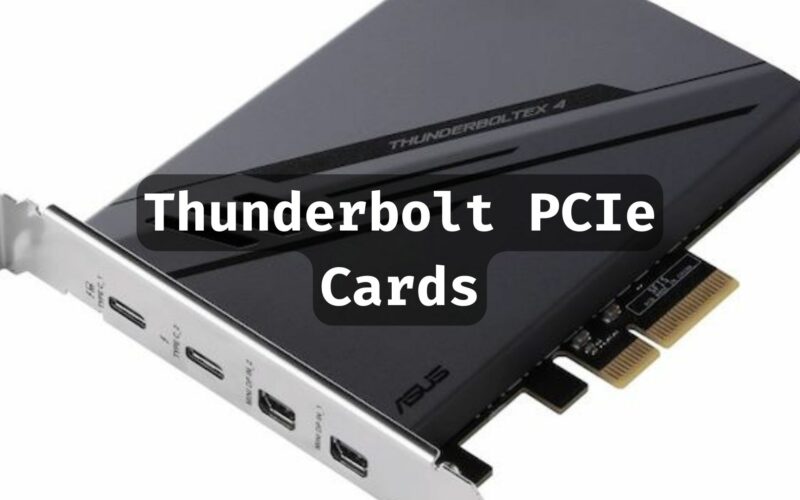Investing in a Thunderbolt PCIe card is the easiest way to add Thunderbolt 4 or Thunderbolt 3 support to a PC that didn’t previously support Thunderbolt. You’ll need a motherboard with a Thunderbolt header and a supported chipset to take full advantage of the fastest and most powerful connectivity available on a computer today.
These are the best Thunderbolt PCIe cards you can buy for your motherboard.
Table of Contents
- Best Thunderbolt PCIe Cards Compared
- 1. ASUS ThunderboltEX 4 – ThunderboltEX 4 PCIe Card for ASUS Motherboards
- 2. GIGABYTE GC-MAPLE RIDGE – ThunderboltEX 4 PCIe Card for GIGABYTE Motherboards
- 3. ASRock THUNDERBOLT 4 AIC – Thunderbolt 4 on Intel and AMD PCs
- 4. GIGABYTE GC-TITAN RIDGE 2.0 – Best Thunderbolt 3 PCIe Card
- 5. HP Thunderbolt 3 PCIe 2-port I/O Card – Thunderbolt 3 Card for HP Workstations
- 6. QNAP Dual-port Thunderbolt 3 Expansion Card – Thunderbolt 3 PCIe Card for QNAP NAS Devices
- Best Thunderbolt PCIe Cards – The Ultimate Buying Guide to Choosing the Best Thunderbolt PCIe Card for Your PC
- Best Thunderbolt PCIe Cards – Frequently Asked Questions (FAQ)
Best Thunderbolt PCIe Cards Compared
| Image | Product | Details | Check Price |
|---|---|---|---|
 | ASUS ThunderboltEX 4 | Thunderbolt Version: Thunderbolt 4 Pin Header Layout: 14-1 Pin External Display: 8K at 60Hz or two 4K at 60Hz Power Delivery: 100W Ports: 2x Thunderbolt 4, 2x Mini DisplayPort IN | Buy on Amazon |
 | GIGABYTE GC-MAPLE RIDGE | Thunderbolt Version: Thunderbolt 4 Pin Header Layout: 5-Pin, 3-Pin (two connectors) External Display: Two 4K at 60Hz Power Delivery: 97W Ports: 2x Thunderbolt 4, 1x DisplayPort 1.4, 2x Mini DisplayPort IN | Buy on Amazon |
 | ASRock THUNDERBOLT 4 AIC | Thunderbolt Version: Thunderbolt 4 Pin Header Layout: 5-Pin External Display: 5K at 60Hz or two 4K at 60Hz Power Delivery: 27W Ports: 2x Thunderbolt 4, 2x DisplayPort IN | Check Price on Newegg |
 | GIGABYTE GC-TITAN RIDGE 2.0 | Thunderbolt Version: Thunderbolt 3 Pin Header Layout: 5-Pin, 3-Pin (two connectors) External Display: Two 4K at 60Hz Power Delivery: 100W Ports: 2x Thunderbolt 3, 1x DisplayPort 1.4, 2x Mini DisplayPort IN | Buy on Amazon |
 | HP Thunderbolt 3 PCIe 2-port I/O Card | Thunderbolt Version: Thunderbolt 3 Pin Header Layout: 2x5-Pin External Display: Two 4K at 60Hz Power Delivery: 15 Ports: 2x Thunderbolt 3, 2x DisplayPort IN | Buy on Amazon |
 | QNAP Dual-port Thunderbolt 3 Expansion Card | Thunderbolt Version: Thunderbolt 3 Pin Header Layout: N/A External Display: N/A Power Delivery: N/A Ports: 2x Thunderbolt 3 (data only) | Buy on Amazon |
1. ASUS ThunderboltEX 4 – ThunderboltEX 4 PCIe Card for ASUS Motherboards
The ASUS ThunderboltEX 4 is the best way to add Thunderbolt 4 ports to your PC, provided you own an ASUS motherboard from the Intel 500 and 600 series. It requires a 14-1 (13 pin) Thunderbolt header, which is only available on ASUS motherboards, meaning you can’t use this card with GIGABYTE, MSI, or ASRock motherboards.
The ThunderboltEX 4 provides two Thunderbolt 4 ports with a 40Gbps bandwidth and up to 100W USB-C charging (the second port does 27W) for laptops and other USB-C devices. It is compatible with USB4 and backward compatible with Thunderbolt 3 devices.
As for monitor support, you can connect a single 8K display at 60Hz or dual 4K displays. But make sure to connect the included Mini DisplayPort cables to the Mini DisplayPort IN port on the card and the DisplayPort output ports on your graphics to enable video support through the Thunderbolt 4 ports. The card allows daisy-chaining of up to five devices per port, which is great for those with many Thunderbolt devices, or multi Thunderbolt monitors setups.
Our Take
The ASUS ThunderboltEX 4 is the best Thunderbolt 4 PCIe card for ASUS motherboards. It is easy to use and delivers the full 100W supported by Thunderbolt 4.
- Works with AMD and Intel motherboards
- 100W Power Delivery
- External display support up to single 8K at 60Hz or dual 4K at 60Hz
- Only supports ASUS motherboards
2. GIGABYTE GC-MAPLE RIDGE – ThunderboltEX 4 PCIe Card for GIGABYTE Motherboards
The GC-MAPLE RIDGE is a Thunderbolt 4 add-in card from GIGABYTE, and like ASUS, it uses a different type of Thunderbolt header. This card requires a 5-pin and 3-pin Thunderbolt header (two connectors), which is available on GIGABYTE motherboards from the Intel Z490 through Z690 series. GIGABYTE officially recommends an Intel 500 series motherboard or later.
The most standing-out feature of the GC-MAPLE RIDGE is the additional DisplayPort output that lets you connect a native DisplayPort monitor without needing dongles—most Thunderbolt 4 add-in cards include only the two Thunderbolt 4 ports.
The Thunderbolt 4 ports on this card allow dual external displays up to 4K at 60Hz, daisy-chaining up to five devices per port, and Power Delivery up to 97W. It’s an overall well-built PCIe card and works flawlessly with compatible GIGABYTE motherboards.
Our Take
The GIGABYTE GC-MAPLE RIDGE uses a 5-pin and 3-pin Thunderbolt header, available on the latest Intel 500 and 600 series GIGABYTE motherboards, making it the best option for GIGABYTE motherboard owners.
- Additional DisplayPort output
- 97W Power Delivery
- Great built quality
- Expensive
3. ASRock THUNDERBOLT 4 AIC – Thunderbolt 4 on Intel and AMD PCs
The ASRock THUNDERBOLT 4 AIC is compatible with motherboards that use a 5-pin Thunderbolt header, including most of the latest 500 and 600 series boards from ASRock. It is also compatible with AMD motherboards that feature a 5-pin header, including X570 motherboards from ASRock and GIGABYTE.
Right now, the only motherboards that come with onboard Thunderbolt 4 ports are the ASUS ProArt B550-Creator and ProArt X570-Creator WIFI, so the THUNDERBOLT 4 AIC from ASRock should give you more options for AMD-powered builds.
Like most cards, the two Thunderbolt 4 ports on this card deliver 40Gbps of peripheral bandwidth, which allows for high data transfer rates and support for dual 4K external displays at 60Hz or a single 5K display at 60Hz. Unfortunately, this card only provides up to 27W of charging power. It’s still plenty enough for fast-charging phones and tablets, though.
Our Take
The ASRock THUNDERBOLT 4 AIC brings Thunderbolt 4 support to motherboards using a 5-pin header, including the latest boards from ASRock.
- It uses a standard 5-pin connector
- 27W charging power
- Officially compatible with AMD motherboards
- Lower Power Delivery than its competitors
4. GIGABYTE GC-TITAN RIDGE 2.0 – Best Thunderbolt 3 PCIe Card
The GIGABYTE GC-TITAN RIDGE 2.0 is a Thunderbolt 3 PCIe card based on the Intel DSL7540 Thunderbolt 3 controller. It’s compatible with motherboards that use a 5-pin or 5-pin plus 3-pin Thunderbolt headers; that’s all Intel 300 and 400 series motherboards from GIGABYTE, MSI, and ASRock. It also works with X570 and B550 AMD motherboards featuring a Thunderbolt header.
If you’re on the GIGABYTE Z490 platform, you’ll need to use both the 5-pin and 3-pin Thunderbolt header cables as these boards have two Thunderbolt connectors. For the rest of the motherboards with a standard 5-pin header, you don’t have to use the included 3-pin header cable. For ASUS boards, you’ll be limited to the Z390 and X299 series.
The GC-TITAN RIDGE 2.0 delivers a total 100W charging power supported by Thunderbolt 3 and faster 40Gbps speeds. It has two Thunderbolt 4 ports and an additional DisplayPort output that lets you connect a native DisplayPort monitor. Talking of monitors, you can connect a single 5K monitor or dual 4K monitors via the DisplayPort and Thunderbolt ports.
Our Take
The GIGABYTE GC-TITAN RIDGE 2.0 beats the competition thanks to its 100W power delivery, more ports, and exhaustive compatibility list. Overall, the best Thunderbolt 3 add-in card available.
- Compatible with both AMD and Intel motherboards
- Whopping 100W Power Delivery
- Extra DisplayPort output port
- Not compatible with ASUS Z490 motherboards
5. HP Thunderbolt 3 PCIe 2-port I/O Card – Thunderbolt 3 Card for HP Workstations
The HP Thunderbolt 3 PCIe 2-port I/O Card is an excellent Thunderbolt 3 PCIe card for the HP Z4 G4, HP Z6 G4, and HP Z8 G4 Workstations. It has two Thunderbolt 4 ports with 40Gbps data transfer speeds and two DisplayPort inputs for display passthrough from your GPU.
The card provides an easy way to add high-bandwidth connectivity to your workstation, allowing for faster file sharing, editing, and quick backups. You can connect multiple 4K displays, Thunderbolt 3 external SSDs and NAS devices, RAID storage, or a Thunderbolt 3 docking station to add even more ports to plug in all of your devices.
Unfortunately, this card won’t work with other types of motherboards as it uses a 2×5-pin Thunderbolt header. Most Thunderbolt 3-enabled motherboards have a 5-pin header.
Our Take
The HP Thunderbolt 3 PCIe 2-port I/O Card upgrades your HP Z Workstation to the latest and fastest Thunderbolt 3 connectivity to easily tackle high bandwidth-intensive tasks such as 4K editing, backups, and large file sharing.
- Seamless compatibility with HP Z Workstations
- 15W USB-C charging
- Supports video and data
- Not compatible with other motherboards (requires a 2×5-Pin header connector)
6. QNAP Dual-port Thunderbolt 3 Expansion Card – Thunderbolt 3 PCIe Card for QNAP NAS Devices
The QNAP Dual-port Thunderbolt 3 Expansion Card transforms your QNAP NAS, such as the TVS-h1688X and TVS-h1288X, into a Thunderbolt 3 NAS, allowing you to transfer files at a lightning-fast 40Gbps speed. This is handy in high-bandwidth workflows such as video editing, collaborative projects, and more.
Since the card has two Thunderbolt 3 ports, you can daisy-chain up to six QNAP Thunderbolt NAS devices for an even higher storage capacity. However, this card only supports data transfers. The Thunderbolt ports don’t deliver any charging power or support external displays.
Our Take
The QNAP Dual-port Thunderbolt 3 Expansion Card is a simple Thunderbolt 3 card that adds two Thunderbolt ports to any QNAP NAS with a PCIe 3.0 x4 slot.
- Faster 40Gbps transfer speeds
- Easy to transform your NAS into Thunderbolt 3 NAS
- Supports daisy-chaining up to six QNAP Thunderbolt devices
- No support for external display and charging
Best Thunderbolt PCIe Cards – The Ultimate Buying Guide to Choosing the Best Thunderbolt PCIe Card for Your PC
Whether you’re looking for a Thunderbolt 3 PCIe card or a Thunderbolt 4 PCIe card, the following factors will help you find just the right adapter for your motherboard. Alternatively, if you’re considering a broader upgrade, you can get a motherboard with a built-in thunderbolt 4.
Thunderbolt PCIe Card Compatibility – Pin Layout
Thunderbolt PCIe cards require a motherboard with a Thunderbolt header, but there is more. The pin layout of the Thunderbolt header is different from one motherboard manufacturer to another, meaning you can use the same Thunderbolt card on every motherboard with a Thunderbolt header.
ASUS uses a 14-1 Pin Thunderbolt header connector for its motherboards from the Intel 400 series, AMD B550 series, and later models; ASRock uses a standard 5-pin header for all of its motherboards; GIGABYTE uses a 5-pin header for its Intel 300 to 400 series and AMD motherboards and a 5-pin plus 3-pin headers for some of its Intel 400 series and later models; MSI uses a 5-pin header for its Intel 300 and 400 series boards and a new 16-pin header for the Intel 500 and later models.
Except for MSI’s Intel 500 series and later models, you can find a compatible Thunderbolt PCIe card for all of these motherboards.
Available PCIe 3.0 x4 Expansion Slot
All Thunderbolt PCIe cards require a PCIe 3.0 x4 slot on your motherboard. Ensure you have an available slot on your PC before buying a PCIe add-in card.
Number of Ports
All Thunderbolt 3 and Thunderbolt 4 PCIe cards provide two Thunderbolt ports, but GIGABYTE went further to add a DisplayPort output. If you have a native DisplayPort monitor with no Thunderbolt ports, the cards from GIGABYTE are the ideal choice.
Specs
Other specs like 40Gbps transfer speeds and support for dual 4K at 60Hz displays remain standard on every Thunderbolt PCIe card. Don’t fall victim to the brand’s marketing gimmicks.
However, if you want future-proof support for 8K displays, go for a Thunderbolt 4 PCIe card.
Best Thunderbolt PCIe Cards – Frequently Asked Questions (FAQ)
How to install a Thunderbolt PCIe card?
A Thunderbolt PCIe card comes with four cables: a Thunderbolt header cable, a USB 2.0 internal cable, and two Mini DisplayPort cables. You need to connect all these cables to your motherboard to take advantage of data, video, and power. Some cards require updating the BIOS after installation.
Why do Thunderbolt PCIe cards come with Mini DisplayPort Cables?
The Mini DisplayPort cables included in a Thunderbolt PCIe card enable display output from the Thunderbolt ports. Connect one of the Mini DisplayPort cables to the DisplayPorts on your GPUs and the other end to the DisplayPort inputs on the Thunderbolt PCIe card.
Can I add Thunderbolt 3 to my motherboard?
You can Thunderbolt 3 to your motherboard using a Thunderbolt 3 PCIe card if the motherboard has a Thunderbolt header.
Does Thunderbolt use PCIe lanes?
Thunderbolt uses four lanes of PCI Express Gen 3 to enable faster transfer speeds up to 40Gbps.
Do AMD motherboards support Thunderbolt?
Both X570 and B550 AMD motherboards support Thunderbolt 3 and Thunderbolt 4, but it is up to the manufacturer to include a Thunderbolt header. Select AMD motherboards from GIGABYTE, ASRock, and ASUS support Thunderbolt.






![Best Speakers For Mac Mini [2023] 51 reduced min speakers](https://bytexd.com/wp-content/uploads/2022/11/reduced_min_speakers-380x220.jpg)